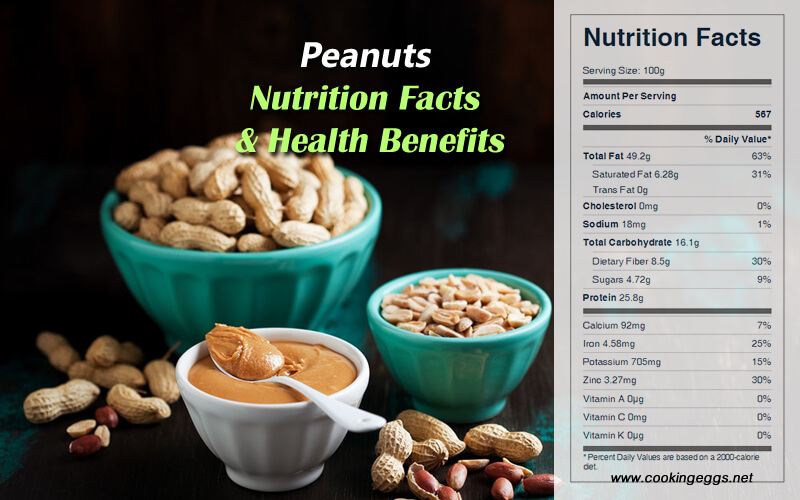Peanuts Nutrition Facts & Health Benefits
Peanuts are not actually nuts but legumes. They are native to Central and South America, but they are now grown and eaten around the world. The peanut, also known as the groundnut, goober, or monkey nut, is a legume crop grown mainly for its edible seeds. It is classified as both a grain legume and, due to its high oil content, an oil crop.
Peanuts are Americans' favorite nuts, even though they’re not really nuts at all, but legumes closely related to beans. We consider them nuts because they share a similar nutritional profile. Peanuts are similar in taste and nutritional profile to tree nuts such as walnuts and almonds, and they are often served in similar ways in western cuisines.

The nutritional value of peanuts
One ounce (approximately 48 peanuts) contains 15% of your daily vitamin E requirement, 2.5 grams of fiber, calcium, copper, iron, magnesium, niacin, folate, and zinc, as well as 7 grams of protein.
In a 100-gram reference serving, peanuts provide 570 kcal of food energy and 25 g of protein, a higher proportion than in many tree nuts. They are an excellent source of several B vitamins, vitamin E, several dietary minerals, such as manganese (95% DV), magnesium (52% DV), and phosphorus (48% DV), and dietary fiber.
Two tablespoons of unsalted all-natural peanut butter provide 210 calories, 6 g carbohydrate, 8 g protein, 16 g fat, 2 g dietary fiber, and 0.36 mg iron.
A common cooking and salad oil, peanut oil contains 46% monounsaturated fats (primarily oleic acid), 32% polyunsaturated fats (primarily linoleic acid), and 17% saturated fats (primarily palmitic acid).
Raw Peanuts Nutrition Facts Label
Health Benefits of Peanuts
Like other legumes, peanuts are a rich source of both protein and fiber. Although peanuts are relatively low in the amino acids cysteine and methionine, they are high in lysine, and they balance well with grains, which are high in methionine but low in lysine. Dietary fiber accounts for nearly half of the carbohydrates in peanuts (12.4 grams in one cup).
Peanuts are used to help fight malnutrition. Peanuts can be used like other legumes and grains to make a lactose-free, milk-like beverage, peanut milk, which is promoted in Africa as a way to reduce malnutrition among children.
Peanuts contain polyphenols, polyunsaturated and monounsaturated fats, phytosterols, and dietary fiber in amounts similar to several tree nuts.
Peanuts are also a very good source of niacin and folate and a significant source of pantothenic acid, magnesium, phosphorus, and zinc. Although peanuts are nearly half fat by weight, approximately half of that fat is monounsaturated, with only 13% being saturated fat.
Some studies show that regular consumption of peanuts is associated with a lower specific risk of mortality from certain diseases. Eating 1.5 ounces per day of most nuts (such as peanuts) as part of a diet low in saturated fat and cholesterol may reduce the risk of heart disease.
Roasted peanuts may rival some berries for antioxidant content, including resveratrol and Coenzyme Q10.
Peanut skins contain resveratrol, which is under preliminary research for its potential effects on humans. Eat peanuts with the red skins on so we can get the considerable benefits of all those polyphenols.
Peanut flour is used in gluten-free cooking. Peanut flour is made from crushed, fully or partly defatted peanuts. Culinary professionals use peanut flour as a thickener for soups, as a flavor and aromatic enhancer in breads, pastries, and main dishes.
The nutritional benefits of peanut butter depend on how it is made. All-natural, fresh-ground peanut butters are the most like peanuts, though you have to remember that any peanut butter is much more calorie-dense than whole peanuts. Peanut butter tends to have more sugar and fat but less fiber than whole peanuts, though they are still a high-quality source of protein, fiber, energy, vitamins, and minerals.
A large-scale experiment has shown that a teaspoon of peanut butter five days a week produces an average weekly weight loss of one pound. The monounsaturated fats reduce cholesterol and prevent heart disease. With a very low glycemic index rating, peanuts may also help to prevent adult-onset diabetes since they hardly raise blood sugar levels. They also provide vitamin B3, folate, and protein. Peanuts and organic peanut butter should be part of a healthy diet.
Health Risk
Raw peanuts also sometimes carry a mold called Aspergillus that can be dangerous to health. It's a carcinogen.
Some people experience allergic reactions to peanut exposure; symptoms are specifically severe for this nut, and can range from watery eyes to anaphylactic shock, which is generally fatal if untreated. Eating a small amount of peanuts can cause a reaction.